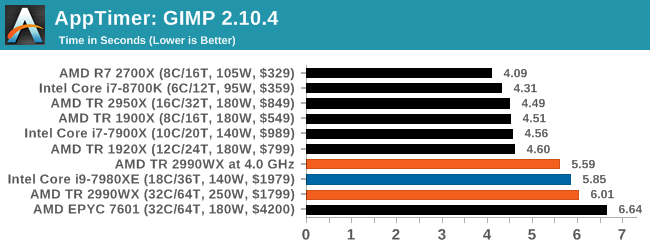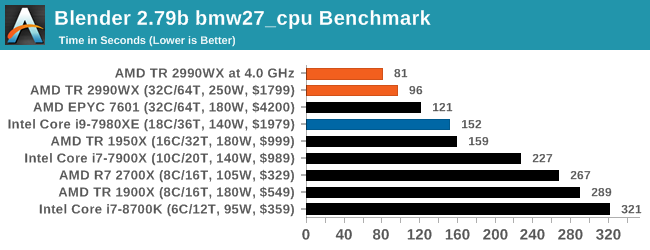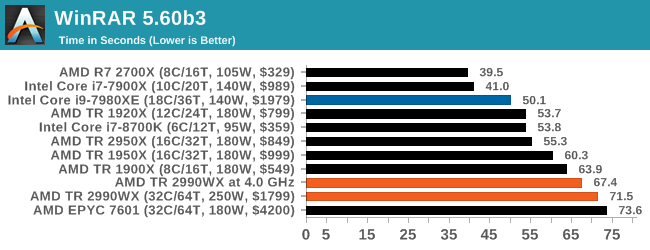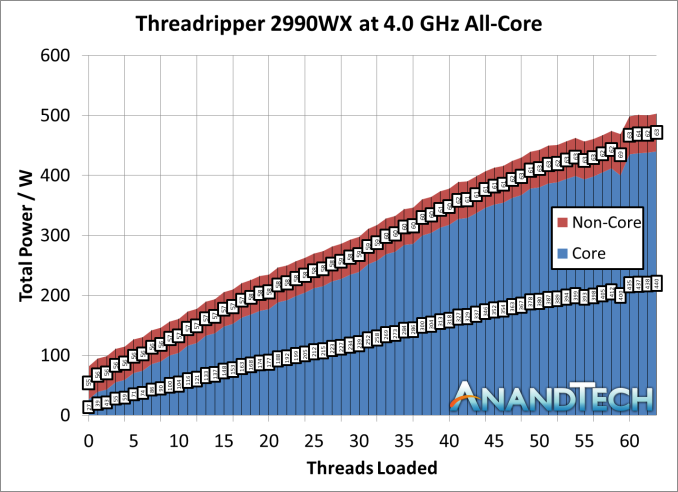The AMD Threadripper 2990WX 32-Core and 2950X 16-Core Review
by Dr. Ian Cutress on August 13, 2018 9:00 AM ESTOverclocking: 4.0 GHz for 500W
Who said that a 250W processor should not be overclocked? AMD prides itself as being a processor manufacturer that offers every consumer processor as a multiplier unlocked part, as well as using a soldered thermal interface material to assist with thermal dissipation performance. This 2990WX has an X in the same, so let the overclocking begin!
Actually, confession time. We did not have much time to do overclocking by any stretch. This processor has a 3.0 GHz base frequency and a 4.2 GHz turbo frequency, and in an air-conditioned room using the 500W Enermax Liqtech cooler, when running all cores under POV-Ray, we observed each core running around 3150 MHz, which is barely above the turbo frequency. The first thing I did was set the all-core turbo to 4.2 GHz, the same as the single core turbo frequency. That was a bust.
However, the next stage of my overclocking escapades surprised me. I set the CPU to a 40x multiplier in the BIOS, for 4.0 GHz on all the cores, all the time. I did not adjust the voltage, it was kept at auto, and I was leaving the ASUS motherboard to figure it out. Lo and behold, it performed flawlessly through our testing suite at 4.0 GHz. I was shocked.
All I did for this overclock was turn a setting from ‘auto’ to ‘40’, and it breezed through almost every test I threw at it. I say almost every test – our Prime95 power testing failed. But our POV-Ray power testing, which draws more power, worked. Every benchmark in the suite worked. Thermals were high (in the 70s), but the cooler could take it, and with good reason too.
At full load in our POV-Ray test, the processor was listed as consuming 500W. The cooler is rated for 500W. At one point we saw 511W. This was split between 440W for the cores (or 13.8W per core) and 63W for the non-core (IF, IO, IMC) which equates to only 12.5% of the full power consumption. It answers the question from our Infinity Fabric power page - if you want the interconnect to be less of the overall power draw, overclock!
We also tried 4.1 GHz, and that seemed to work as well, although we did not get a full benchmark run out of it before having to pack the system up. As stated above, 4.2 GHz was a no-go, even when increasing the voltage. With tweaking (and the right cooling), it could be possible. For anyone wanting to push here, chilled water might be the way to go.
Performance at 4.0 GHz
So if the all-core frequency was 3125 MHz, an overclock to 4000 MHz all-core should give a 28% performance increase, right? Here are some of the key tests from our suite.






Overclocking the 2990WX is a mixed bag, because of how it does really well in some tests, and how it still sits behind the 2950X in others due to the bi-modal nature of the cores. In the tests were it already wins, it pushes out a lot more: Blender is up 19% in throughput, POV-Ray is up 19%, 3DPM is up 19%. The other tests, is catches back up to the 2950X (Photoscan), or still lags behind (app loading, WinRAR).
Overclocking is not the cure-all for the performance issues on the 2990WX, but it certainly does help.











171 Comments
View All Comments
Eastman - Tuesday, August 14, 2018 - link
Just a comment regarding studios and game developers. I work in the industry and 90% of these facilities do run with Xeon workstations and ECC memory. Either custom built or purchased from the likes of Dell or HP. So yes, there is a market place for workstations. No serious pro would do work on a mobile tablet or phone where there is a huge market growth. There is definitely a place for a single 32 core CPUs. But among say 100 workstations there might be a place for only 4-5 of the 2990WX. Those would serve particles/fluids dynamics simulation. Most of the workload would be sent to render farms sometimes offsite. Those render farms could use Epyc/Xeon chips. If I was a head of technology, I would seriously consider these CPUs for my artists workflow.ATC9001 - Wednesday, August 15, 2018 - link
Another big thing which people don't consider is...the true "price" of these systems is nearly neck and neck. Sure you can save a couple hundred with AMD CPU, but by the time you add in RAM, mobo, PSU, storage etc....you're talking a 5k+...Intel doesn't want AMD to go away (think anti-trust) but they are definitely stepping up efforts which is great for consumers!
LsRamAir - Thursday, August 16, 2018 - link
We've been patient! Looked at all the ads multiple times for support to. Please drop the rest of the knowledge, Sir! "Still writing" on the overclocking page is nibblin' at my patience and intrigue hemisphere.Relic74 - Wednesday, August 29, 2018 - link
Yes of course there is, I have one of the new 32 core systems and I use it with SmartOS. A VM management OS that could allow up to 8 game developers to use a single 32 Core workstation without a single bit of performance lost. That is as long as each VM has control over their own GPU. 4 Cores(most games dont new more than that in fact, no game needs more that), 32GB to 64GB of RAM (depending on server config) and an Nvidia 1080ti or higher, per VM. That is more than enough and would save the company thousands, in fact, that is exactly what most game developers use. Servers with 8 to 12 GPU's, dual CPUs, 32 to 64 cores, 512GB of RAM, standard config.You should watch Linus Tech Tips 12 node gaming system off of a single computer, it's the future and is amazing.
eek2121 - Saturday, August 18, 2018 - link
You are downplaying the gaming market. It's a multi-billion dollar industry. Nothing niche about it.HStewart - Monday, August 13, 2018 - link
I agree with you - so this mainly concerning "It's over, Intel is finished"Normally I don't care much to discuss AMD related threads - but when people already bad mouth Intel, it all fair game in my opinion.
But what is important and why I agree is that it not even close. Because the like it or not, PC Game industry which primary reason for desktop now is a minimal part of industry now - computers are mostly going to mobile - and just go into local BestBuy and you see why it not even close.
Plus as in a famous WW II saying, "The Sleeper has been Awaken". One is got to be blind, if you think "Intel is finished" I think the real reason that 10nm is not coming out, is that Intel wants to shut down AMD for once and for always. I see this coming in two areas - in the CPU area and also with GPU - I believe the i870xG is precursor to it - with AMD GPU being replace with Artic Sound.
But AMD does have a good side to this. That it keep Intel's prices down and Intel improving products.
ishould - Monday, August 13, 2018 - link
"I think the real reason that 10nm is not coming out, is that Intel wants to shut down AMD for once and for always." This is actually not true, Intel is having *major* yield issues with 10nm, hence 14nm being a 4-year-node (possibly 5 years if it slips from the expected Holiday 2019), and is a contributing factor for the decline of Intel/rise of AMD.HStewart - Monday, August 13, 2018 - link
I not stating that Intel didn't have yield issues - but there is 2 things that should be taking in account - and of course Intel only really knows1. (Intel has stated this) That all 10nm are not equal - and then Intel's 10nm is closer to competition's 7nm - and this is likely the reason why it taking long.
2. Intel realizes the process issues - and if you think they are not aware of competition in market - not just AMD but also ARM then one is a fool
ishould - Monday, August 13, 2018 - link
I agree they were probably being too ambitious with their scaling (2.4x) for 10nm. Rumor is that they've had to sacrifice some scaling to get better yields. EUV cannot come soon enough!MonkeyPaw - Monday, August 13, 2018 - link
I highly highly doubt that Intel would postpone 10nm just to “shut down AMD.” Intel has shareholders to look out for, and Intel needs 10nm out the door yesterday. Their 10nm struggles are real, and it is costing them investor confidence. No way would they wait around to win a pissing match with AMD while their stock value goes down.